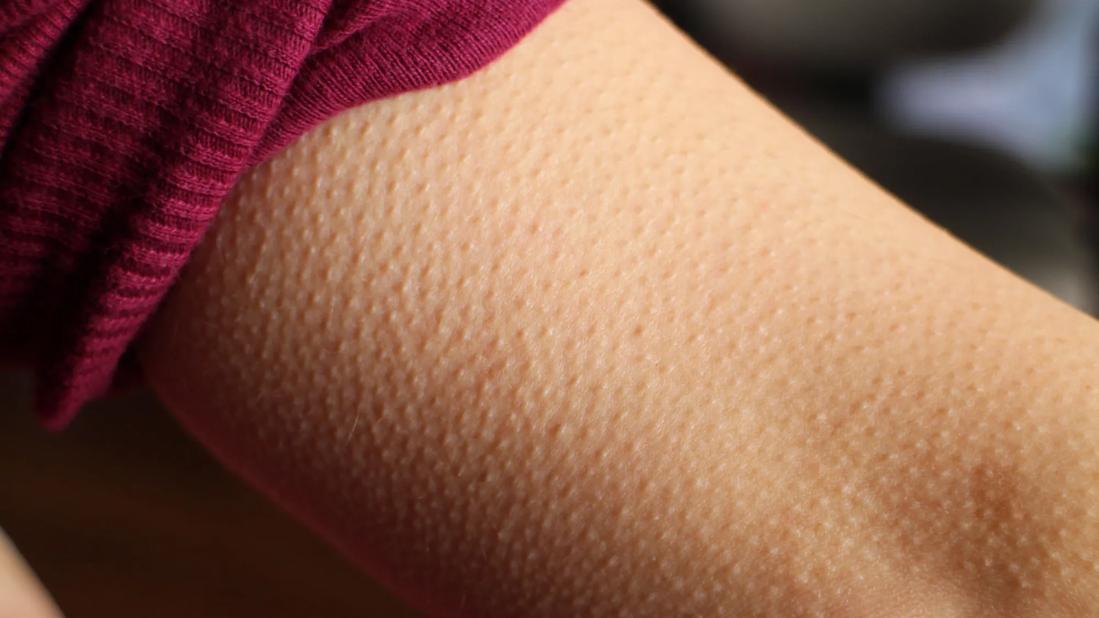This automatic flight-or-fight response makes your hair stand on end, causing little harmless bumps to form for every hair follicle

Goosebumps pop up for a variety of reasons, like when you get the chills or have a sudden feeling of fear or excitement. They’ve happened to every one of us at some point in our lives. But have you ever stopped to think about what’s actually raising your skin?
Advertisement
Cleveland Clinic is a non-profit academic medical center. Advertising on our site helps support our mission. We do not endorse non-Cleveland Clinic products or services. Policy
Family medicine nurse practitioner Sara Fandino, APRN, explains the biological and psychological reasons behind the phenomenon, as well as whether goosebumps could be a sign of a more serious medical issue.
Goosebumps, or piloerections, are an involuntary, automatic reaction that occurs whenever your sympathetic nervous system (or fight-or-flight mode) is triggered. In response, tiny muscles contract at the base of each hair follicle. This causes your hairs to bristle or stand on end, resulting in tiny bumps. These can occur anywhere on your body where you have hair, like your neck, arms or legs.
Beyond cold weather temps, goosebumps can pop up automatically as part of our fight-or-flight response and as a result of other psychological and neurological processes that include:
A recent study discovered the nerves that cause tiny muscles to contract beneath hair follicles are the same nerves that stimulate hair follicle stem cells and future hair growth. So, it makes sense why cold weather may result in the thickening of an animal’s fur, in addition to causing their hair to stand on end. The result is that they appear larger and more of a threat to other predators. (Think of a cat that puffs up and pulls back onto its hind legs while it hisses).
Advertisement
But here in the human world, goosebumps don’t appear to have much of a purpose beyond helping us conserve heat. When we’re exposed to a sudden drop in temperature or get the chills, our hair follicles are forced to rise up, closing our pores and trapping what remaining body heat we have underneath the surface of our skin. Conserving heat is very important not only because of the mild discomfort that we may feel when we get cold, but also because it’s essential for the optimal function of our bodies.
“Maintaining a stable temperature is crucial for our overall health, and the human body is perfectly designed to inform us when things are jeopardizing our well-being,” says Fandino. “It’s amazing to see how effective the human body is at communicating dangers through different, simple signals that something could be wrong, while at the same time, reminding us that it’s always working to protect us.”
Goosebumps themselves are nothing to worry about. But every once in a while, if they’re persistent without any known cause, they can be a symptom of an underlying condition like:
Bottom line? While there are rare instances when goosebumps may suggest a medical issue, they’re usually just an outward reflection of big emotions or a literal chill. If anything, they’re your body’s response to the world around you and a helpful reminder that your internal biological processes are wonderfully complex and wide-ranging.
Advertisement
Learn more about our editorial process.
Advertisement

This important skin care ingredient helps protect your skin and keep it moisturized

Early attention to skin wounds can help minimize their appearance later

Several conditions, like vitiligo and fungal infection, can cause a loss of pigmentation, leading to white spots or patches on your skin

Moisturizing, running a humidifier and adjusting your showers may help keep itchiness and irritation at bay

‘Zit stickers’ can help heal a new or popped pimple, but they’re limited when it comes to managing acne

Glycolic acid benefits skin tone, texture and pigmentation by exfoliating dead skin

At-home treatments and lifestyle changes may help ease the symptoms and improve the appearance of varicose veins — but they aren’t a cure

Any fever, especially one of 100.5 degrees Fahrenheit or higher, should trigger a call to your oncologist — and maybe a trip to the ER

The best parenting style balances enforcing rules and showing plenty of love

Tips include cutting back on sugar, focusing on exercise and managing stress

It can be harder to let go when you’ve invested time, energy and emotions — but it might be the healthier choice long term